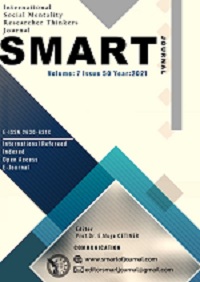Author :
Abstract
Herhangi bir nesnenin içinde yer aldığı, işlevi doğrultusunda anlam kazandığı doğal alanı o nesnenin mekanıdır. Sanatsal mekan ise sanat yapıtlarının içinde sergilendiği alandır. Kavramsal sanatla birlikte heykel ve resim arasındaki sınırlar bulanıklaşmış, sanata konu olan melez nesnenin sergilendiği alan, en az yapıtın kendisi kadar önemli hale gelmiştir. Nesneler, sanat nesnesine dönüşürken ayrı ayrı ya da bütünsel bir anlam ilettiklerine dair bazı argümanlara ihtiyaç duymaktadırlar. Bu argümanlardan birisi, yapıtı sanatsal hassasiyetle çevrili bir galeri ya da müze içinde sergileyerek izleyici üzerindeki gizli kaygıyı azaltmak ve nesneyi meşrulaştırmaktır. Bir galeri ya da müzeye adım attığımız anda mekanın büyüsü ve dönüştürücü etkisiyle, gördüğümüz her nesne kendi arketipi olarak görünmekte ve mekan ise buna garantörlük etmektedir. Bunun yanı sıra mekanın seküler varlığından sıyrılması ve kendi başına bir sanat nesnesi olması ya da büyük ölçekli ve sınırları olmayan alanların da mekana dair bir metafor olarak sergilenebilmesi, artık güncel sanatın kendisiyle iç içe geçmiş düzenleme biçimleridir. Bu çalışmada mekanın nesneyi sanat nesnesine dönüştürme yönündeki gücü, mekanın bizzat kendisinin bir sanat nesnesi olabileceği ve sınırları olmayan alanların da sanata dahil edilebileceğine yönelik algı incelenmiştir.
Keywords
Abstract
The natural space in which any object takes place and gains meaning in line with its function is the space of that object. Artistic space is the space in which works of art are exhibited. With the conceptual art, the boundaries between sculpture and painting have blurred, and the area where the hybrid object, which is the subject of art, is exhibited has become at least as important as the work itself. Objects need some arguments as to whether they convey a separate or holistic meaning as they become art objects. One of these arguments is to reduce the hidden anxiety on the viewer and legitimize the object by exhibiting the work in a gallery or museum surrounded by artistic sensitivity. As soon as we step into a gallery or museum, with the magic and transformative effect of the space, every object we see appears as its own archetype and the space is the guarantor of this. In addition, the space's being stripped of its secular existence and becoming an art object in its own right, or the large-scale and borderless spaces to be exhibited as a metaphor for space are now intertwined forms of arrangement with contemporary art. In this study, the power of the space to transform the object into an art object, the perception that the space itself can be an art object and that areas without borders can be included in art are examined.
Keywords
- ANTMEN, Ahu, 2010. 20. Yüzyıl Batı Sanatında Akımlar. İstanbul: Sel Yayıncılık.
- ANTMEN, Ahu, 2010. 20. Yüzyıl Batı Sanatında Akımlar. İstanbul: Sel Yayıncılık.
- CHOWN, Marcus, 2015. Biraz Kuantumdan Zarar Gelmez. Çev. Taylan Taftaf, İstanbul: Alfa Bilim Yayıncılık.
- LEFEBVRE, Henri, 2015. Mekanın Üretimi. Çev. Işık Ergüden, İstanbul: Sel Yayıncılık.
- O’DOHERTY, Brian, 2013. Beyaz Küpün İçinde-Galeri Mekânının İdeolojisi. Çev. Ahu Antmen, İstanbul: Sel Yayıncılık.
- WILSON, Michael, 2015. Çağdaş Sanat Nasıl Okunur. Çev. Firdevs Candil Erdoğan, İstanbul: HayalperestŞekil 1. https://www.gsd.harvard.edu/2019/11/socks-studio-part-visual-atlas-part-psychological-voyage-into- the-unknown/ adresinden 10.06.2021 tarihinde alınmıştır.
- Şekil 2. https://tr.pinterest.com/pin/497858933813026293/ adresinden 13.06.2021 tarihinde alınmıştır.
- Şekil 3. https://feldmangallery.com/exhibition/023-white-light-white-heat-chris-burden, adresinden 13.06.2021 tarihinde alınmıştır.
- Şekil 4. https://www.noshowmuseum.com/en/1st-a/maria-eichhorn , adresinden 15.06.2021 tarihinde alınmıştır.
- Şekil 5. http://www.modernedition.com/art-articles/absence-in-art/empty-art-gallery-shows.html adresinden 16.06.2021 tarihinde alınmıştır.
- Şekil 6. https://www.milliyet.com.tr/dunya/gozlugu-sanat-eseri-sandilar-2252132 adresinden 18.06.2021 tarihinde alınmıştır.
- Şekil 7. https://artmap.com/portikus/exhibition/jimmie-durham, adresinden 18.06.2021 tarihinde alınmıştır. Şekil 8. https://ursfischer.com/images/14323 adresinden 20.06.2021 tarihinde alınmıştır.
- Şekil 9. https://www.zestandcuriosity.com/2020/02/02/cornelia-parker-i-got-lucky-in-sydney/adresinden Şekil 10. https://xxi.com.tr/i/land-art-ve-cagdaslari, adresinden 21.06.2021 tarihinde alınmıştır.
- Şekil 11. http://yatooi.com/44991?ckattempt=1 adresinden 23.06.2021 tarihinde alınmıştır.





